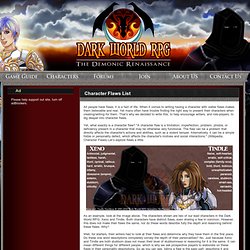

Art. Dark World RPG - Character Flaws List. All people have flaws; it is a fact of life.

When it comes to writing having a character with viable flaws makes them believable and real. Yet many often have trouble finding the right way to present their characters when creating/writing for them. That’s why we decided to write this, to help encourage writers, and role-players, to dig deeper into character flaws. Yet, what exactly is a character flaw?
"A character flaw is a limitation, imperfection, problem, phobia, or deficiency present in a character that may be otherwise very functional. As an example, look at the image above. Well, for starters, their writers had to look at their flaws and determine why they have them in the first place. Using the list below can help you find flaws to build your character – but your work is not done yet. A common misconception in character building is that players feel they have to use the 'exact' flaw listed, or that the flaws are just 'black and white' no shades of gray. The Table Theory of Characterization. Monday, February 4, 2013 So you’ve written a fantasy novel.

It’s full of political intrigue and clashing armies, nefarious wizards and heroic last stands. Now strip all of that away. That rollercoaster of a plot with its byzantine twists? Gone. If your protagonists never stumbled across The Plot of your novel (or caused it, for that matter) would they still be interesting? This is my litmus test for writing interesting characters, and I call it The Table Theory of Characterization. It comes out of Joss Whedon’s Firefly. Under the Table Theory of Characterization, dialogue becomes much more important. Body language remains equally important. It’s also important to understand how the different characters will all get along. Subtext is also vital in anything dramatic. Of course, any plot that doesn’t alter the characters’ personalities in varying ways is a failure to some extent. Title image by Kazuya Takahashi. Rating: 9.5/10 (21 votes cast) About the Author. How to Craft Compelling Characters. The source and exact nature of the curious phenomena we refer to as characters remains something of a mystery, but the craft of characterization is not.

Although it’s clearly a cause for celebration—or at least relief—when a character appears in the mind’s eye fully formed, the reality is that for most of us, this is a rare occurrence. Certain techniques are required to will our characters to life. We need to draw on the unconscious, memory, the imagination and the Muse until our characters quicken, assume clear form and, with hope, begin to act of their own accord. Can this process—so inherent to the success of any novel—really be condensed into a single method? In my experience as both writer and writing instructor, the answer is, to some extent, yes.
The most compelling characters are those who appear internally consistent and yet are capable of surprise. A Driving Need, Desire, Ambition or Goal A Secret We are our own best source for understanding secrets. 25 Things You Should Know About Character. Previous iterations of the “25 Things” series: 25 Things Every Writer Should Know 25 Things You Should Know About Storytelling And now… Here you’ll find the many things I believe — at this moment!

— about characters: 1. Without character, you have nothing. 2. A great character can be the line between narrative life and story death. 3. Don’t believe that all those other aspects are separate from the character. 4. The audience will do anything to spend time with a great character. 5. It is critical to know what a character wants from the start. 6. It doesn’t matter if we “like” your character, or in the parlance of junior high whether we even “like-like” your character. 7.
It is critical to smack the audience in the crotchal region with an undeniable reason to give a fuck. 8. You must prove this thesis: “This character is worth the audience’s time.” 9. Don’t let the character be a dingleberry stuck to the ass of a toad as he floats downriver on a bumpy log.